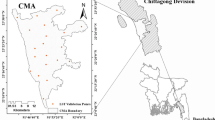Abstract
Landsat ETM + imagery is useful for analyzing urban thermal environments because it provides visible and near-infrared data. However, this approach is limited by the low resolution of Landsat images compared to the unit size of buildings in urban areas, which complicates any attempt to apply these images to the urban scale in terms of district unit plans or architectural plans. This paper describes a methodology that improves the accuracy of surface temperature analysis in urban areas by using satellite imagery and associated land cover data. Land cover types in the city of Goyang, South Korea, were reclassified into biotope types and climatope types. Moran’s I was then calculated for the thermal infrared images according to the land cover types. Resampling the Landsat ETM + thermal infrared images according to the pixel content ratio and performing supervised classifications based on biotope and climatope maps improved the accuracy of the surface temperature evaluation in an urban area. Moran’s I values of 0.9066 and 0.9279 were found according to the classification system of biotope and climatope maps, respectively. In addition, reclassification using supervised spatial autocorrelation and Moran’s I may provide better results than other methods applied to surface temperature evaluations of complex urban areas. These results verified that reclassifying the land cover type based on biotope and climatope maps and determining the spatial autocorrelation within the classified data leads to a more accurate evaluation of the surface temperature distribution by land cover type than observed for any other classification method.






Similar content being viewed by others
References
Almeida-Filho R, Shimabukuro YE (2002) Digital processing of a Landsat-TM time series for mapping and monitoring degraded areas caused by independent gold miners, Roraima State, Brazilian Amazon. Remote Sensing of Environment 79(1): 42–50
Baumueller J (1998) Stadtklima 21. Landeshauptstadt Stuttgart
Bradley BA, Mustard JF (2005) Identifying land cover variability distinct from land cover change: Cheatgrass in the Great Basin. Remote Sens Environ 94(2):204–213
Chen X-L, Zhao H-M et al (2006) Remote sensing image-based analysis of the relationship between urban heat island and land use/cover changes. Remote Sens Environ 104(2):133–146
Cho M, Lee K, Kim U (2001) A study on the spatial distribution characteristic of urban surface temperature using Remotely Sensed Data and GIS. J KAGIS 4(1): 57–66
Cingolani AM, Renison D et al (2004) Mapping vegetation in a heterogeneous mountain rangeland using landsat data: an alternative method to define and classify land cover units. Remote Sens Environ 92(1): 84–97
Cohen WB, Maiersperger TK et al (2003) An improved strategy for regression of biophysical variables and Landsat ETM + data. Remote Sens Environ 84(4):561–571
Eliasson I (2000) The use of climate knowledge in urban planning. Landsc Urban Plann 48:31–44
Fily M, Bourdelles B et al (1997) Comparison of in situ and Landsat Thematic Mapper derived snow grain characteristics in the alps. Remote Sens Environ 59(3):452–460
Finke L (1986) Landscape ecology, Braunschweig, Germany
Fotheringham AS, Brunsdon C, Charlton M (2000) Quantitative Geography – Perspectives on Spatial Data Analysis. Sage Publications
Hashiba H, Kameda K et al (1998) Analysis of landuse change in periphery of Tokyo during last twenty years using the same seasonal landsat data. Adv Space Res 22(5):681–684
Kirch W, Menne B, Bertolini R (2005) Extreme Weather Events and Public Health Responses. Springer
Lee K, Cho M (2004) Analysis of Urban Surface Temperature Distribution Properties Using Spatial Information Technologies. Korean J Remote Sens 20(6):397–408
Liu J, Liu M et al (2005) Spatial and temporal patterns of China’s cropland during 1990–2000: An analysis based on Landsat TM data. Remote Sens Environ 98(4):442–456
Ministry of Economy Baden-Wuerttemberg (1998) Climate booklet for urban development, references for zoning and planning. Stuttgart, Germany. http://www.staedtebaulicheklimafibel.de/Climate_Booklet/index-1.htm
Nichol JE (1994) Modelling the relationship between LANDSAT TM thermal data and urban morphology. ASPRS/ACSM 1:494–502
Song Y (2005) Influence of new town development on the urban heat island – The case of the Bundang area. Jour of Environmental Sciences 17(4):641–645
Teillet PM, Barker JL, Markhamb BL, Irishc RR, Fedosejevsa G, Storeyd JC (2001) Radiometric cross-calibration of the Landsat-7 ETM + and Landsat-5 TM sensors based on tandem data sets. Remote Sens Environ 78: 39–54
Xian G, Crane M (2006) An analysis of urban thermal characteristics and associated land cover in Tampa Bay and Las Vegas using Landsat satellite data. Remote Sens Environ 104(2):147–156
Yuan F, Sawaya KE et al (2005) Land cover classification and change analysis of the Twin Cities (Minnesota) Metropolitan Area by multitemporal Landsat remote sensing. Remote Sens Environ 98(2–3):317–328
Author information
Authors and Affiliations
Corresponding author
Additional information
Communicated by H. Babaie
Publisher’s Note
Springer Nature remains neutral with regard to jurisdictional claims in published maps and institutional affiliations.
Rights and permissions
Springer Nature or its licensor holds exclusive rights to this article under a publishing agreement with the author(s) or other rightsholder(s); author self-archiving of the accepted manuscript version of this article is solely governed by the terms of such publishing agreement and applicable law.
About this article
Cite this article
Song, Y., Song, J. Analysis of surface temperature in an urban area using supervised spatial autocorrelation and Moran’s I. Earth Sci Inform 15, 2545–2552 (2022). https://doi.org/10.1007/s12145-022-00856-x
Received:
Revised:
Accepted:
Published:
Issue Date:
DOI: https://doi.org/10.1007/s12145-022-00856-x




